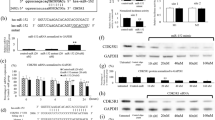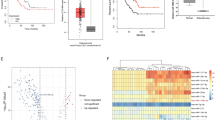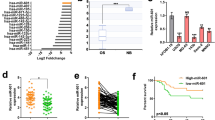Abstract
Ewing sarcoma is a pediatric bone tumor characterized in 85% of cases by the fusion between EWS and FLI1 genes that results in the expression of the EWS-FLI1 aberrant transcription factor. Histologically, the Ewing tumor expresses high levels of the CD99 membrane glycoprotein. It has been recently described that CD99 expression contributes to the Ewing tumor oncogenesis by modulating growth and differentiation of tumor cells. Different studies have also shown that overexpression of EWS-FLI1 induces CD99 expression in non-Ewing cells. At the opposite, the knockdown of EWS-FLI1 expression by siRNA approaches has no significant effect on CD99 mRNA level in Ewing cells. Here, by in vivo and in vitro studies, we show that while EWS-FLI1 inhibition has only slight effects on the amount of CD99 transcript, it induces a dramatic decrease of the CD99 protein expression level, hence suggesting post-transcriptional regulations, possibly mediated by microRNAs. To further investigate this issue, we identified a set of 91 miRNAs that demonstrate EWS-FLI1 modulation, three of them being predicted to bind CD99 3′ untranslated region (3′UTR). Among these, we show that miR-30a-5p has the ability to interact with the 3′UTR region of CD99 and to regulate its expression. Moreover, the re-expression of miRNA-30a-5p in Ewing cell line induces decreased cell proliferation and invasion. In this study, we therefore show that miR-30a-5p constitutes a major functional link between EWS-FLI1 and CD99, two critical biomarkers and therapeutic targets in Ewing sarcoma.
This is a preview of subscription content, access via your institution
Access options
Subscribe to this journal
Receive 50 print issues and online access
$259.00 per year
only $5.18 per issue
Buy this article
- Purchase on Springer Link
- Instant access to full article PDF
Prices may be subject to local taxes which are calculated during checkout




Similar content being viewed by others
References
Delattre O, Zucman J, Plougastel B, Desmaze C, Melot T, Peter M et al. Gene fusion with an ETS DNA-binding domain caused by chromosome translocation in human tumours. Nature 1992; 359: 162–165.
Erkizan HV, Uversky VN, Toretsky JA . Oncogenic partnerships: EWS-FLI1 protein interactions initiate key pathways of Ewing’s sarcoma. Clin Cancer Res 2010; 16: 4077–4083.
Toomey EC, Schiffman JD, Lessnick SL . Recent advances in the molecular pathogenesis of Ewing's sarcoma. Oncogene 2010; 29: 4504–4516.
Chansky HA, Hu M, Hickstein DD, Yang L . Oncogenic TLS/ERG and EWS/Fli-1 fusion proteins inhibit RNA splicing mediated by YB-1 protein. Cancer Res 2001; 61: 3586–3590.
Sanchez G, Delattre O, Auboeuf D, Dutertre M . Coupled alteration of transcription and splicing by a single oncogene: boosting the effect on cyclin D1 activity. Cell Cycle 2008; 7: 2299–2305.
Yang L, Chansky HA, Hickstein DD . EWS.Fli-1 fusion protein interacts with hyperphosphorylated RNA polymerase II and interferes with serine-arginine protein-mediated RNA splicing. J Biol Chem 2000; 275: 37612–37618.
Braunreiter CL, Hancock JD, Coffin CM, Boucher KM, Lessnick SL . Expression of EWS-ETS fusions in NIH3T3 cells reveals significant differences to Ewing's sarcoma. Cell Cycle 2006; 5: 2753–2759.
May WA, Gishizky ML, Lessnick SL, Lunsford LB, Lewis BC, Delattre O et al. Ewing sarcoma 11;22 translocation produces a chimeric transcription factor that requires the DNA-binding domain encoded by FLI1 for transformation. Proc Natl Acad Sci USA 1993; 90: 5752–5756.
Castillero-Trejo Y, Eliazer S, Xiang L, Richardson JA, Ilaria RL . Expression of the EWS/FLI-1 oncogene in murine primary bone-derived cells Results in EWS/FLI-1-dependent, Ewing sarcoma-like tumors. Cancer Res 2005; 65: 8698–8705.
Riggi N, Cironi L, Provero P, Suva ML, Kaloulis K, Garcia-Echeverria C et al. Development of Ewing's sarcoma from primary bone marrow-derived mesenchymal progenitor cells. Cancer Res 2005; 65: 11459–11468.
Bernard G, Raimondi V, Alberti I, Pourtein M, Widjenes J, Ticchioni M et al. CD99 (E2) up-regulates alpha4beta1-dependent T cell adhesion to inflamed vascular endothelium under flow conditions. Eur J Immunol 2000; 30: 3061–3065.
Schenkel AR, Mamdouh Z, Chen X, Liebman RM, Muller WA . CD99 plays a major role in the migration of monocytes through endothelial junctions. Nat Immunol 2002; 3: 143–150.
Bernard G, Breittmayer JP, de Matteis M, Trampont P, Hofman P, Senik A et al. Apoptosis of immature thymocytes mediated by E2/CD99. J Immunol 1997; 158: 2543–2550.
Pettersen RD, Bernard G, Olafsen MK, Pourtein M, Lie SO . CD99 signals caspase-independent T cell death. J Immunol 2001; 166: 4931–4942.
Sohn HW, Shin YK, Lee IS, Bae YM, Suh YH, Kim MK et al. CD99 regulates the transport of MHC class I molecules from the Golgi complex to the cell surface. J Immunol 2001; 166: 787–794.
Bremond A, Meynet O, Mahiddine K, Coito S, Tichet M, Scotlandi K et al. Regulation of HLA class I surface expression requires CD99 and p230/golgin-245 interaction. Blood 2009; 113: 347–357.
Cerisano V, Aalto Y, Perdichizzi S, Bernard G, Manara MC, Benini S et al. Molecular mechanisms of CD99-induced caspase-independent cell death and cell-cell adhesion in Ewing’s sarcoma cells: actin and zyxin as key intracellular mediators. Oncogene 2004; 23: 5664–5674.
Scotlandi K, Baldini N, Cerisano V, Manara MC, Benini S, Serra M et al. CD99 engagement: an effective therapeutic strategy for Ewing tumors. Cancer Res 2000; 60: 5134–5142.
Sohn HW, Choi EY, Kim SH, Lee IS, Chung DH, Sung UA et al. Engagement of CD99 induces apoptosis through a calcineurin-independent pathway in Ewing’s sarcoma cells. Am J Pathol 1998; 153: 1937–1945.
Kreppel M, Aryee DN, Schaefer KL, Amann G, Kofler R, Poremba C et al. Suppression of KCMF1 by constitutive high CD99 expression is involved in the migratory ability of Ewing’s sarcoma cells. Oncogene 2006; 25: 2795–2800.
Rocchi A, Manara MC, Sciandra M, Zambelli D, Nardi F, Nicoletti G et al. CD99 inhibits neural differentiation of human Ewing sarcoma cells and thereby contributes to oncogenesis. J Clin Invest 2010; 120: 668–680.
Miyagawa Y, Okita H, Nakaijima H, Horiuchi Y, Sato B, Taguchi T et al. Inducible expression of chimeric EWS/ETS proteins confers Ewing's family tumor-like phenotypes to human mesenchymal progenitor cells. Mol Cell Biol 2008; 28: 2125–2137.
Riggi N, Suva ML, Suva D, Cironi L, Provero P, Tercier S et al. EWS-FLI-1 expression triggers a Ewing’s sarcoma initiation program in primary human mesenchymal stem cells. Cancer Res 2008; 68: 2176–2185.
Hu-Lieskovan S, Zhang J, Wu L, Shimada H, Schofield DE, Triche TJ . EWS-FLI-1 fusion protein up-regulates critical genes in neural crest development and is responsible for the observed phenotype of Ewing's family of tumors. Cancer Res 2005; 65: 4633–4644.
Rorie CJ, Thomas VD, Chen P, Pierce HH, O’Bryan JP, Weissman BE . The Ews/Fli-1 fusion gene switches the differentiation program of neuroblastomas to Ewing sarcoma/peripheral primitive neuroectodermal tumors. Cancer Res 2004; 64: 1266–1277.
Esquela-Kerscher A, Slack FJ . Oncomirs - microRNAs with a role in cancer. Nat Rev Cancer 2006; 6: 259–269.
Ban J, Jug G, Mestdagh P, Schwentner R, Kauer M, Aryee DN et al. Hsa-mir-145 is the top EWS-FLI1-repressed microRNA involved in a positive feedback loop in Ewing’s sarcoma. Oncogene 2011; 30: 2173–2180.
McKinsey EL, Parrish JK, Irwin AE, Niemeyer BF, Kern HB, Birks DK et al. A novel oncogenic mechanism in Ewing sarcoma involving IGF pathway targeting by EWS/Fli1-regulated microRNAs. Oncogene 2011; 30: 4910–4920.
Riggi N, Suva ML, De Vito C, Provero P, Stehle JC, Baumer K et al. EWS-FLI-1 modulates miRNA145 and SOX2 expression to initiate mesenchymal stem cell reprogramming toward Ewing sarcoma cancer stem cells. Genes Dev 2010; 24: 916–932.
De Vito C, Riggi N, Suva ML, Janiszewska M, Horlbeck J, Baumer K et al. Let-7a is a direct EWS-FLI-1 target implicated in Ewing’s sarcoma development. PLoS ONE 2011; 6: e23592.
Lessnick SL, Dacwag CS, Golub TR . The Ewing’s sarcoma oncoprotein EWS/FLI induces a p53-dependent growth arrest in primary human fibroblasts. Cancer Cell 2002; 1: 393–401.
Tirode F, Laud-Duval K, Prieur A, Delorme B, Charbord P, Delattre O . Mesenchymal stem cell features of Ewing tumors. Cancer Cell 2007; 11: 421–429.
Fabian MR, Sonenberg N, Filipowicz W . Regulation of mRNA translation and stability by microRNAs. Annu Rev Biochem 2010; 79: 351–379.
Cironi L, Riggi N, Provero P, Wolf N, Suva ML, Suva D et al. IGF1 is a common target gene of Ewing’s sarcoma fusion proteins in mesenchymal progenitor cells. PLoS ONE 2008; 3: e2634.
Li J, Donath S, Li Y, Qin D, Prabhakar BS, Li P . miR-30 regulates mitochondrial fission through targeting p53 and the dynamin-related protein-1 pathway. PLoS Genet 2010; 6: e1000795.
Martinez I, Cazalla D, Almstead LL, Steitz JA, DiMaio D . miR-29 and miR-30 regulate B-Myb expression during cellular senescence. Proc Natl Acad Sci USA. 2011; 108: 522–527.
Zaragosi LE, Wdziekonski B, Le Brigand K, Villageois P, Mari B, Waldmann R et al. Small RNA sequencing reveals miR-642a-3p as a novel adipocyte-specific microRNA and miR-30 as a key regulator of human adipogenesis. Genome Biol 2011; 12: R64.
Zhong X, Li N, Liang S, Huang Q, Coukos G, Zhang L . Identification of microRNAs regulating reprogramming factor LIN28 in embryonic stem cells and cancer cells. J Biol Chem 2010; 285: 41961–41971.
Calin GA, Liu CG, Sevignani C, Ferracin M, Felli N, Dumitru CD et al. MicroRNA profiling reveals distinct signatures in B cell chronic lymphocytic leukemias. Proc Natl Acad Sci USA 2004; 101: 11755–11760.
Garzon R, Croce CM . MicroRNAs in normal and malignant hematopoiesis. Curr Opin Hematol 2008; 15: 352–358.
Bandres E, Cubedo E, Agirre X, Malumbres R, Zarate R, Ramirez N et al. Identification by real-time PCR of 13 mature microRNAs differentially expressed in colorectal cancer and non-tumoral tissues. Mol Cancer 2006; 5: 29.
Schetter AJ, Leung SY, Sohn JJ, Zanetti KA, Bowman ED, Yanaihara N et al. MicroRNA expression profiles associated with prognosis and therapeutic outcome in colon adenocarcinoma. JAMA 2008; 299: 425–436.
Yanaihara N, Caplen N, Bowman E, Seike M, Kumamoto K, Yi M et al. Unique microRNA molecular profiles in lung cancer diagnosis and prognosis. Cancer Cell 2006; 9: 189–198.
Budhu A, Jia HL, Forgues M, Liu CG, Goldstein D, Lam A et al. Identification of metastasis-related microRNAs in hepatocellular carcinoma. Hepatology 2008; 47: 897–907.
Szafranska AE, Davison TS, John J, Cannon T, Sipos B, Maghnouj A et al. MicroRNA expression alterations are linked to tumorigenesis and non-neoplastic processes in pancreatic ductal adenocarcinoma. Oncogene 2007; 26: 4442–4452.
Baffa R, Fassan M, Volinia S, O’Hara B, Liu CG, Palazzo JP et al. MicroRNA expression profiling of human metastatic cancers identifies cancer gene targets. J Pathol 2009; 219: 214–221.
Yu F, Deng H, Yao H, Liu Q, Su F, Song E . Mir-30 reduction maintains self-renewal and inhibits apoptosis in breast tumor-initiating cells. Oncogene 2010; 29: 4194–4204.
Kumarswamy R, Mudduluru G, Ceppi P, Muppala S, Kozlowski M, Niklinski J et al. MicroRNA-30a inhibits epithelial-to-mesenchymal transition by targeting snai1 and is downregulated in non-small cell lung cancer. Int J Cancer 2011; 130: 2044–2053.
Melot T, Dauphinot L, Sevenet N, Radvanyi F, Delattre O . Characterization of a new brain-specific isoform of the EWS oncoprotein. Eur J Biochem 2001; 268: 3483–3489.
Melot T, Gruel N, Doubeikovski A, Sevenet N, Teillaud JL, Delattre O . Production and characterization of mouse monoclonal antibodies to wild-type and oncogenic FLI-1 proteins. Hybridoma 1997; 16: 457–464.
Lee MT, Coburn GA, McClure MO, Cullen BR . Inhibition of human immunodeficiency virus type 1 replication in primary macrophages by using Tat- or CCR5-specific small interfering RNAs expressed from a lentivirus vector. J Virol 2003; 77: 11964–11972.
Fujita S, Iba H . Putative promoter regions of miRNA genes involved in evolutionarily conserved regulatory systems among vertebrates. Bioinformatics 2008; 24: 303–308.
Boeva V, Surdez D, Guillon N, Tirode F, Fejes AP, Delattre O et al. De novo motif identification improves the accuracy of predicting transcription factor binding sites in ChIP-Seq data analysis. Nucleic Acids Res 2010; 38: e126.
Guillon N, Tirode F, Boeva V, Zynovyev A, Barillot E, Delattre O . The oncogenic EWS-FLI1 protein binds in vivo GGAA microsatellite sequences with potential transcriptional activation function. PLoS ONE 2009; 4: e4932.
Acknowledgements
We thank the members of the cytometry plateform of tumor biology department of the Institut Curie for the cell selection by FACS. This work was supported by grants from the Ligue Nationale Contre le Cancer (Equipe labelisé), the INCa (n° 2009-1-PLBIO-04-IC-1), and the following associations: Courir pour Mathieu, Dans les pas du Géant, Olivier Chape, Les Bagouzamanon and les Amis de Claire. Georges-Alain Franzetti is a recipient of a fellowship from the Ministère de l’Enseignement Supérieur et de la Recherche (France).
Author information
Authors and Affiliations
Corresponding author
Ethics declarations
Competing interests
The authors declare no conflict of interest.
Additional information
Supplementary Information accompanies the paper on the Oncogene website
Rights and permissions
About this article
Cite this article
Franzetti, GA., Laud-Duval, K., Bellanger, D. et al. MiR-30a-5p connects EWS-FLI1 and CD99, two major therapeutic targets in Ewing tumor. Oncogene 32, 3915–3921 (2013). https://doi.org/10.1038/onc.2012.403
Received:
Revised:
Accepted:
Published:
Issue Date:
DOI: https://doi.org/10.1038/onc.2012.403
Keywords
This article is cited by
-
Long noncoding RNA HCG18 inhibits the differentiation of human bone marrow-derived mesenchymal stem cells in osteoporosis by targeting miR-30a-5p/NOTCH1 axis
Molecular Medicine (2020)
-
miRNA signatures in childhood sarcomas and their clinical implications
Clinical and Translational Oncology (2019)
-
Clofarabine inhibits Ewing sarcoma growth through a novel molecular mechanism involving direct binding to CD99
Oncogene (2018)
-
CD99 at the crossroads of physiology and pathology
Journal of Cell Communication and Signaling (2018)
-
The putative tumor suppressor microRNA-30a-5p modulates clear cell renal cell carcinoma aggressiveness through repression of ZEB2
Cell Death & Disease (2017)



